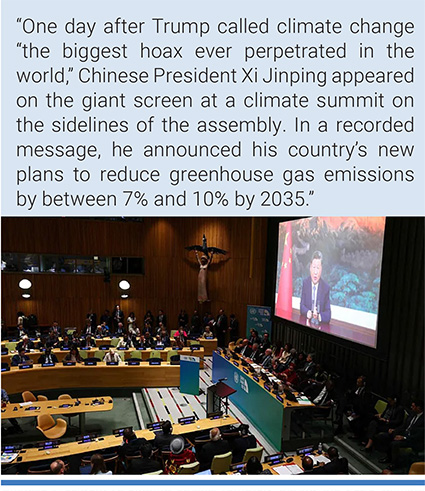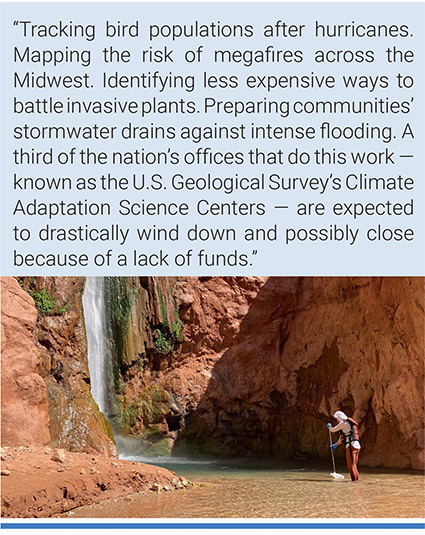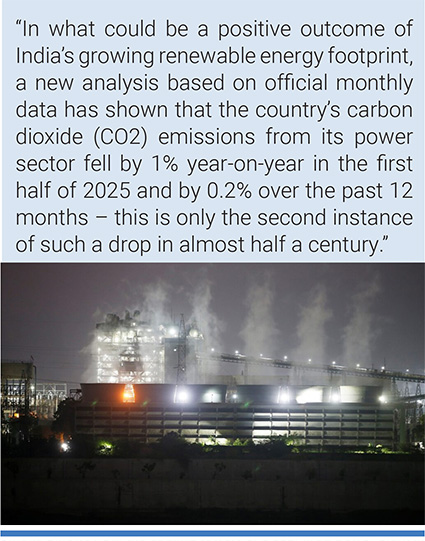Monthly Summaries
Issue 105, September 2025 | "In front of drowning nations"
[DOI]
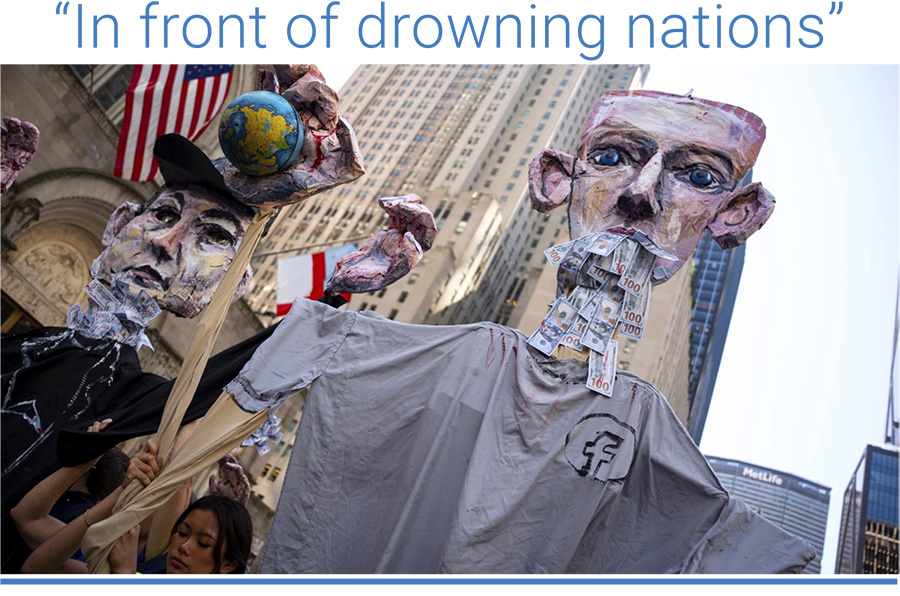
Art pieces of Mark Zuckerberg and Elon Musk with bloody hands carrying globes are marched through Manhattan at the “Make Billionaires Pay” climate protest, September 2025, in New York. Photo: Angelina Katsanis/AP.
September media coverage of climate change or global warming in newspapers around the globe increased 22% from August 2025. However, coverage in September 2025 decreased 16% from September 2024 levels. Figure 1 shows trends in newspaper media coverage at the global scale – organized into seven geographical regions around the world – from January 2004 through September 2025. International wire services stories in September 2025 were down 9% from August 2025 as well as down 33% from September 2024. For another month in 2025, the quantity of media coverage nonetheless still struggles to keep pace with the pace of a changing climate itself.

Figure 1. Newspaper media coverage of climate change or global warming in print sources in seven different regions around the world, from January 2004 through September 2025.
At the regional level, September 2025 coverage increased in all regions compared to August 2025: the European Union (EU) (+5%), North America (+8%), Asia (+10%), Latin America (+15%), Africa (+22%), Oceania (+88%), and in the Middle East (more than doubling) compared to August 2025. In the United States (US), print media coverage went up 12% from August 2025 yet was still 18% lower than coverage in September 2024 (Figure 2). Meanwhile, US television coverage surged from low levels of August 2025 coverage is it was up 57% despite still remaining 19% lower than September 2024 levels.

Figure 2. International wire services coverage of climate change or global warming from January 2000 through September 2025.
Moving to the content of news coverage about climate change in September 2025, topping news reporting were many political and economic-themed media stories about climate change or global warming. To begin, early September news of California Attorney General’s office lawsuit – and counter lawsuit – against ExxonMobil – regarding recent developments was part of an ongoing set of stories. For example, New York Times journalist Karen Zraick wrote, “did California’s attorney general and several other groups defame Exxon Mobil when they sued the oil giant last year over its role in widespread plastic pollution? That was the question looming over a recent hearing in federal court in Beaumont, Texas, where Exxon Mobil has countersued Attorney General Rob Bonta of California and the nonprofit groups, accusing them of mounting a conspiracy to destroy its recycling business. Exxon’s aggressive move signaled a sharp escalation by the oil giant as it tries to ward off similar suits in the future… Paul Nolette, a professor at Marquette University in Milwaukee and author of a book on state attorneys general, said that a company filing a defamation lawsuit against an attorney general was highly unusual. He said it was most likely a tactic to push back on what he described as the “soft power” that state attorneys general possess, such as the ability to pursue legal investigations and make public statements that can influence public opinion and potentially pressure corporate defendants. He also noted the similarities between Mr. Bonta’s plastics lawsuit and another batch of litigation: the roughly three-dozen suits filed by state and local governments since 2017 against oil companies over their role in climate change. Those cases allege that the oil companies covered up what they knew about global warming to protect profits. The climate change lawsuits are generally being filed by states led by Democrats, Mr. Nolette noted, which has the effect of making them look more political, which in turn encourages companies like Exxon to push back more aggressively. He added that he thought Exxon was trying to raise the costs of bringing plastics-related litigation to discourage other states from following California’s lead. There have been lawsuits related to plastics pollution filed by officials in New York and Minnesota, for example, but they are far fewer in number than climate change lawsuits. “It’s something of a branch off of the existing climate litigation,” Mr. Nolette said of the plastics lawsuit. “I think, from the company’s perspective, once the genie is out of the bottle, or whatever cliché you want to use, then it becomes a lot more difficult for them to deal with these claims. So they’re trying to push back early”.”
In mid-September, as US President Donald Trump made remarks out of step with the global community, many news outlets covered his remarks as well as early signs of their reverberations. For example – in an article titled ‘In front of drowning nations, Trump calls climate change a ‘con job.’ Here are the facts and context’ – Associated Press journalists Melinda Walling and Seth Borenstein reported, “Some countries’ leaders are watching rising seas threaten to swallow their homes. Others are watching their citizens die in floods, hurricanes and heat waves, all exacerbated by climate change. But the world U.S. President Donald Trump described in his speech at the United Nations General Assembly on Tuesday didn’t match the one many world leaders in the audience are contending with. Nor did it align with what scientists have long been observing. “This ‘climate change,’ it’s the greatest con job ever perpetrated on the world, in my opinion,” Trump said. “All of these predictions made by the United Nations and many others, often for bad reasons, were wrong. They were made by stupid people that have cost their countries fortunes and given those same countries no chance for success. If you don’t get away from this green scam, your country is going to fail.” Trump has long been a critic of climate science and polices aimed at helping the world transition to green energies like wind and solar. His speech Tuesday, however, was one of his most expansive to date. It included false statements and making connections between things that are not connected.” As another example, El Mundo journalist Luis de la Cal wrote, “One day after Trump called climate change "the biggest hoax ever perpetrated in the world," Chinese President Xi Jinping appeared on the giant screen at a climate summit on the sidelines of the assembly. In a recorded message, he announced his country's new plans to reduce greenhouse gas emissions by between 7% and 10% by 2035. "While some countries are acting contrary [to the fight against climate change], the international community must stay focused in the right direction," Xi said in a message addressed to the United States.” “China promises for the first time to reduce its gases to stop global warming” was the main cover story of La Vanguardia on the 26th.
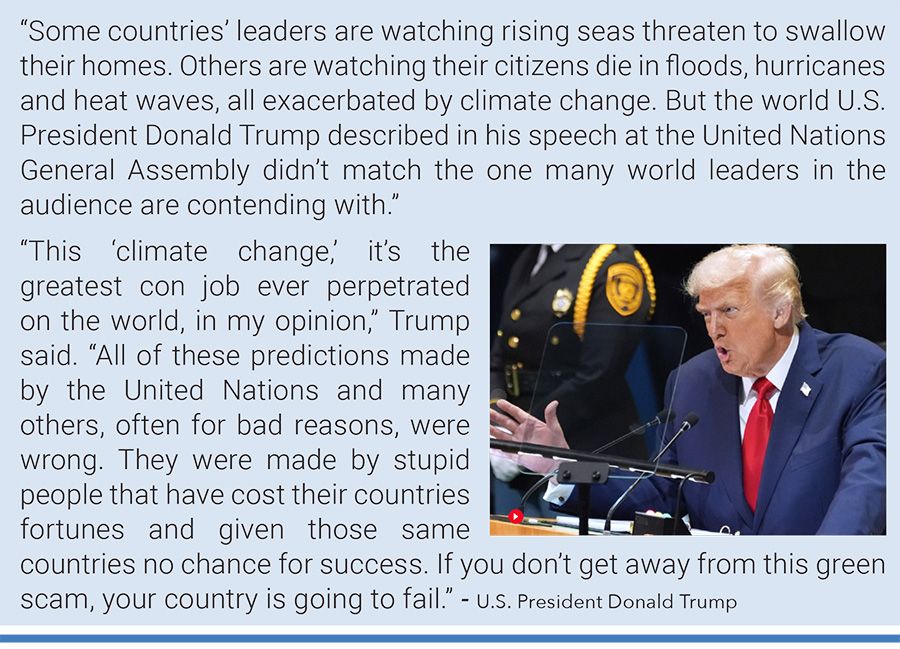
President Donald Trump returned to the United Nations to boast of his foreign policy record, inflating his role at times, and lash out at the world body. Source: Associated Press.
Chinese President Xi Jinping speaks remotely during the 2025 Climate Summit at the UN on September 24, 2025. Photo: Charly Triballeau/AFP. |
Many news outlets also covered US Trump Administration climate affairs in and around the UN General Assembly in New York City up to the end of the month and the looming US government shutdown. For example, New York Times journalist Max Bearak reported, “Energy Secretary Chris Wright and Interior Secretary Doug Burgum defended the Trump administration’s pivot away from renewable energy in Italy on Wednesday, saying their plans to sharply expand U.S. fossil fuel exports were crucial to “peace and prosperity.” The secretaries are swinging through Europe this week on a mission to secure contracts to sell more American fossil fuels and lobby the European Union to loosen environmental regulations that they have said are too onerous. Mr. Wright said he would be in Brussels on Thursday to discuss the European Union’s requirements that oil and gas companies limit leaks of methane, one of the most potent greenhouse gases, and a law requiring companies to prevent adverse human rights and environmental effects in their production process.” Elsewhere, Washington Post journalists Kasha Patel, Jake Spring, Brady Dennis and Hannah Natanson reported, “Tracking bird populations after hurricanes. Mapping the risk of megafires across the Midwest. Identifying less expensive ways to battle invasive plants. Preparing communities’ stormwater drains against intense flooding. A third of the nation’s offices that do this work — known as the U.S. Geological Survey’s Climate Adaptation Science Centers — are expected to drastically wind down and possibly close after Tuesday because of a lack of funds, according to employees and an announcement by one of the closing centers. The potential shuttering of the South Central, Northeast and Pacific Islands centers, which collectively cover about one-third of the U.S. population and are funded under the Interior Department, would hamper projects aimed to help people, wildlife, land, and water adapt to a changing climate locally. Their demise is unconnected to a possible federal shutdown: Instead, employees say, Interior Department officials have not approved paperwork that would help fund them for another five years.”
Meanwhile, in the international energy policy arena there was September news of other global cooperation across nations both positive and negative in terms of climate change. For an example of the former, Times of India correspondent Vishwa Mohan reported, “in what could be a positive outcome of India’s growing renewable energy footprint, a new analysis based on official monthly data has shown that the country’s carbon dioxide (CO2) emissions from its power sector fell by 1% year-on-year in the first half of 2025 and by 0.2% over the past 12 months – this is only the second instance of such a drop in almost half a century. The analysis also indicates that emissions from India’s power sector could peak before 2030 if clean-energy capacity and electricity demand grow as expected”. As a second example of the former, BBC News journalists Mark Poynting and Matt McGrath wrote, “China, the world's biggest source of planet-warming gases, has for the first time committed to an absolute target to cut its emissions. In a video statement to the UN in New York, President Xi Jinping said that China would reduce its greenhouse gas emissions across the economy by 7-10% by 2035, while "striving to do better"”.
A U.S. Geological Survey scientist collects a water quality sample in the Grand Canyon in Arizona. Photo: USGS Climate Adaptation Science Centers. |
For an example of the latter, CNN journalists Simone McCarthy, Nectar Gan and Darya Tarasova wrote, “Russian President Vladimir Putin hailed a relationship with Beijing at an “unprecedentedly high level” on Tuesday, as the two countries reportedly inked a long-stalled agreement to build a massive new pipeline to send natural gas to China via Mongolia. Putin and Xi Jinping spent hours together on Tuesday, meeting with Mongolia’s president, sitting down for their own formal talks, and sipping tea at the Chinese leader’s official residence – in the latest show of solidarity between the two strongmen seeking to present a new world order. On Tuesday afternoon, Russia’s state-owned energy company Gazprom announced that a legally binding agreement had been signed for the construction the massive Power of Siberia-2 gas pipeline, which Moscow has been trying to push off the drawing board for years”. As another example of the latter, the EU's climate leadership was weakened by the disagreement over the new greenhouse gas cuts, diluting its commitment to climate action. La Vanguardia journalist Anna Buj wrote, “Europe noted the enormous differences between EU countries regarding the direction the European Union should follow. The Commission's proposal to reduce greenhouse gas emissions by 90% by 2040 compared to 1990 met with opposition from several countries. And the EU will not be able to submit its updated climate action plan to the United Nations before September 30, as required by the Paris Agreement”.
Next, media portrayals about ecological and meteorological dimensions of a changing climate in September 2025 also threaded political dimensions of climate stories into related and ongoing cultural-themed stories relating to climate change or global warming. To illustrate, further fallout from the contrarian US Department of Energy (DOE) report on climate change made news in September. For example, CNN correspondent Ella Nilsen wrote, “Climate scientists are declaring victory after the Trump administration dissolved a working group of five well-known climate contrarians that authored a recent federal report questioning the severity of climate change and even portraying it as potentially beneficial. A letter dated September 3 from Energy Sec. Chris Wright confirming the dissolution of the group was sent to the five researchers — John Christy and Roy Spencer, both at the University of Alabama at Huntsville, Steven E. Koonin of Stanford University’s Hoover Institution, Georgia Tech professor emeritus Judith Curry and Canadian economist Ross McKitrick. The group’s end can be traced to a lawsuit filed by the Environmental Defense Fund and Union of Concerned Scientists alleging the group’s formation violated the Federal Advisory Committee Act in several ways, mainly by failing to disclose the group’s formation “until months after it began working,” and by choosing members of a federal government working group to deliberately represent a one-sided argument. Though the group has been disbanded, DOE will not withdraw the report it authored, which sparked resistance across the climate science community and stirred a coordinated response during the required public-comment period.”
Smoke billows from the cooling towers of a coal-fired power plant in Ahmedabad, India. Photo: Amit Dave/Reuters. |
As news coverage ramps up ahead of the UN climate negotiations in November in Brazil, some stories with a cultural lens punctuated the news cycle. For example, Folha de São Paulo reporter Luciana Cavalcante wrote, “hundreds of construction workers decided to go on strike for an indefinite period…the strike will directly affect construction work on hotels and properties for COP30, the United Nations climate change summit which takes place in less than two months in the city”.
Then, several September 2025 media stories featured several scientific themes in news accounts. As a first example, research from Imperial College London garnered media attention. For example, Guardian correspondent Ajit Niranjan wrote, “Human-made global heating caused two in every three heat deaths in Europe during this year’s scorching summer, an early analysis of mortality in 854 big cities has found. Epidemiologists and climate scientists attributed 16,500 out of 24,400 heat deaths from June to August to the extra hot weather brought on by greenhouse gases. The rapid analysis, which relies on established methods but has not yet been submitted for peer review, found climate breakdown made the cities 2.2C hotter on average, greatly increasing the death toll from dangerously warm weather. “The causal chain from fossil fuel burning to rising heat and increased mortality is undeniable,” said Friederike Otto, a climate scientist at Imperial College London and a co-author of the report. “If we had not continued to burn fossil fuels over the last decades, most of the estimated 24,400 people in Europe wouldn’t have died this summer.” The scientists used local relationships between temperature and death to model excess mortality during the hottest months of the year, and compared their results – which cover cities where almost one-third of the European population lives – with a hypothetical world without any climate change. They found the extra heat was responsible for about 68% of the estimated deaths. Older people were hit hardest by punishing temperatures, the study found, with 85% of the dead over the age of 65, and 41% over the age of 85”.
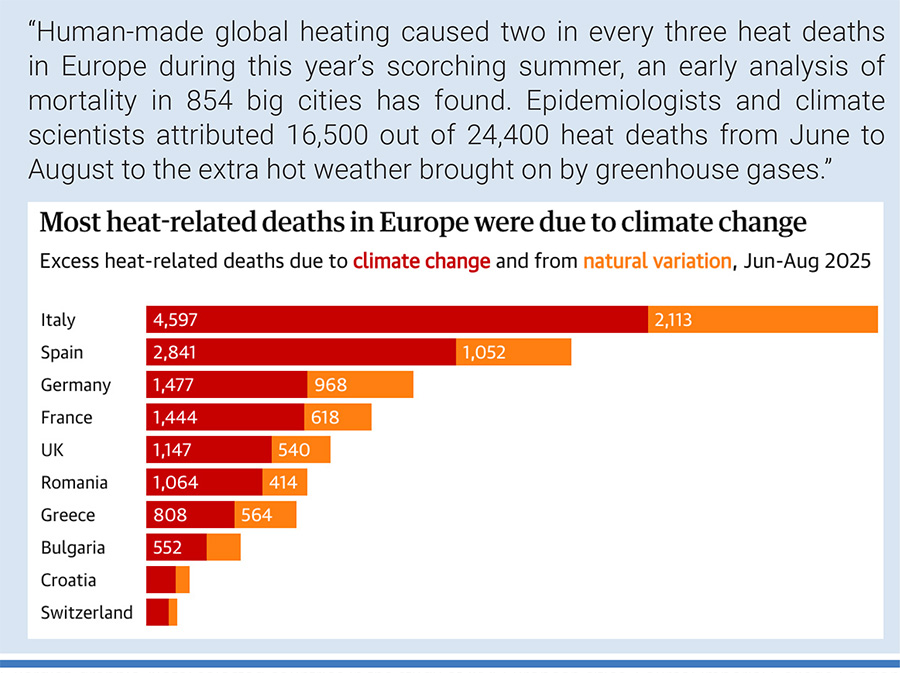
Guardian graphic. Note: selected countries in the study of 854 European cities. Source: Imperial College London and London School of Hygiene & Tropical Medicine.
As a second example, the first National Climate Risk Assessment in Australia generated media accounts. BBC News correspondent Lana Lam noted, “One and a half million Australians living in coastal areas are at risk from rising sea levels by 2050, a landmark climate report has warned…[and] predicted more frequent and severe climate hazards like floods, cyclones, heatwaves, droughts, and bushfires. "Australians are already living with the consequences of climate change today," Climate Change Minister Chris Bowen said, "but it's clear every degree of warming we prevent now will help future generations avoid the worst impacts in years to come." The report looked at three global warming scenarios - above 1.5C, above 2C and above 3C. Australia - one of the world's biggest polluters per capita - has already reached warming of above 1.5C, the report said, noting that at 3C, heat-related deaths in Sydney may rise by more than 400% and almost triple in Melbourne. The 72-page report - released days before the government announces its emissions reduction targets for 2035 - found that no Australian community will be immune from climate risks that will be "cascading, compounding and concurrent". It warned of more heatwave-related deaths, poorer water quality due to severe flooding and bushfires, and a A$611bn ($406bn; £300bn) drop in property values. By 2050, the report found the number of coastal communities located in "high and very high risk areas" in Australia will increase and if populations levels remain stable, this will mean more than 1.5 million people will be at risk”.

Figure 3. Examples of newspaper front pages with climate change stories in September 2025.
Among stories elsewhere, La Vanguardia journalist Andrés Actis noted, “The planet is already exceeding seven of the nine limits that give it stability: ocean acidification is the new threshold that has entered the red zone.” The article reported that “The first scanner, in 2009, showed three limits exceeded. Ten years ago, in 2015, the check added a fourth. In 2023, the number rose to six. Now, to seven. For the first time, the ocean acidification limit has been exceeded. This endangers much of marine life. The acidity of the seas has increased by 40% since the beginning of the industrial era. “Humanity is crossing the boundaries of a safe operating space, which increases the risk of destabilizing the planet,” warns Johan Rockström, director of the Potsdam Institute for Climate Impact Research and lead author of this study.”
Last, in September there were also many ongoing media stories relating political themes to ecological and meteorologicaldimensions of climate change or global warming. To illustrate, New York Times correspondent Hannah Dreier reported, “The U.S. government will provide wildfire fighters with masks to protect against smoke — reversing a decades-long ban that exposed workers to toxins known to cause cancer and other serious diseases. The Forest Service posted new guidance on Monday acknowledging for the first time that masks can protect firefighters against harmful particles in wildfire smoke. The move is part of a flurry of safety improvements in recent weeks as the government faces increasing pressure to aid firefighters. For years, the Forest Service had barred workers from wearing masks, arguing that they were too cumbersome for the job. But current and former officials have said the agency did not want to deal with the potentially costly consequences of admitting the long-term dangers of smoke exposure… The shift comes after a series of articles in The New York Times documented a growing occupational health crisis among wildfire crews. As climate change makes fire season longer and more intense, firefighters are spending more time in smoke. Many are developing cancer or lung disease at young ages, and some are dying. The Forest Service, which employs the largest share of the country’s 40,000 wildland firefighters, has come under intense scrutiny by Congress…

Figure 4. Examples of newspaper front pages from U.S. President Donald Trump's described speech at the United Nations General Assembly in September 2025.
- report prepared by Max Boykoff, Rogelio Fernández-Reyes, Ami Nacu-Schmidt, Jeremiah Osborne-Gowey and Olivia Pearman

